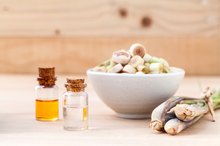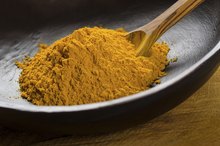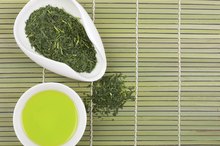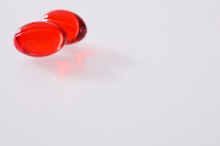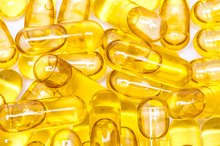What does fact checked mean?
At Healthfully, we strive to deliver objective content that is accurate and up-to-date. Our team periodically reviews articles in order to ensure content quality. The sources cited below consist of evidence from peer-reviewed journals, prominent medical organizations, academic associations, and government data.
- "Molecular Nutrition and Food Research"; Rosmarinic Acid, Major Phenolic Constituent of Greek Sage Herbal Tea, Modulates Rat Intestinal SGLT One Levels with Effects on Blood Glucose; Azevedo MF, et al.; March 2011
- "Molecular Nutrition and Food Research"; Rosmarinic Acid, Major Phenolic Constituent of Greek Sage Herbal Tea, Modulates Rat Intestinal SGLT One Levels with Effects on Blood Glucose; Azevedo MF, et al.; March 2011
- "Journal of Nutrition"; Dietary Anthocyanin Rich Bilberry Extract Ameliorates Hyperglycemia and Insulin Sensitivity Via Activation of AMP Activated Protein Kinase in Diabetic Mice; Takikawa M, et al.; March 2010
- "Journal of Nutrition"; Dietary Anthocyanin Rich Bilberry Extract Ameliorates Hyperglycemia and Insulin Sensitivity Via Activation of AMP Activated Protein Kinase in Diabetic Mice; Takikawa M, et al.; March 2010
- "Journal of Ethnopharmacology"; Effect of Hibiscus Rosa Sinensis Linn. Ethanol Flower Extract on Blood Glucose and Lipid Profile in Streptozotocin Induced Diabetes in Rats; Sachdewa A, et al.; November 2003
- "Journal of Ethnopharmacology"; Effect of Hibiscus Rosa Sinensis Linn. Ethanol Flower Extract on Blood Glucose and Lipid Profile in Streptozotocin Induced Diabetes in Rats; Sachdewa A, et al.; November 2003
- "Journal of Cardiovascular Pharmacology"; Blockade of Nitroxidative Stress by Roasted Licorice Extracts in High Glucose Exposed Endothelial Cells; Choi YJ, et al.; October 2008
- "Journal of Cardiovascular Pharmacology"; Blockade of Nitroxidative Stress by Roasted Licorice Extracts in High Glucose Exposed Endothelial Cells; Choi YJ, et al.; October 2008
The information contained on this site is for informational purposes only, and should not be used as a substitute for the advice of a professional health care provider. Please check with the appropriate physician regarding health questions and concerns. Although we strive to deliver accurate and up-to-date information, no guarantee to that effect is made.
Herbal teas are made from fruits, flowers, roots, bark and other parts of plants other than the tea plant, Camellia sinensis. Evidence of people consuming herbal teas dates back to ancient Egypt and China. For their pleasant flavors and aromas, as well as their purported medicinal effects, herbal teas are a welcome addition to a healthy lifestyle. Some herbal teas are sought after particularly for their reputed ability to stabilize blood sugar.
Sage
Sage tea, a beverage commonly consumed in Turkish-speaking countries, contains a compound called rosmarinic acid that may offer blood sugar regulating effects, according to a study published in the March 2011 issue of the journal "Molecular Nutrition and Food Research." In the study on laboratory animals, two weeks of sage tea consumption stabilized fasting blood glucose levels and inhibited an increase in glucose absorption following carbohydrate meals 1. The researchers concluded that sage tea has blood sugar lowering effects at the intestinal level, modulating glucose absorption.
Bilberry
Are Lemon, Ginger and Honey Good for the Liver?
Learn More
Bilberry, a relative of blueberry, is commonly consumed as a tea and contains among the highest quantities of antioxidant anthocyanin compounds. Bilberry extract was found to have blood sugar lowering properties, in a study published in the March 2010 issue of the "Journal of Nutrition." In the study on laboratory animals, bilberry extract significantly reduced blood sugar levels and increased insulin sensitivity by promoting transport of glucose from the blood into muscles and by suppressing glucose and lipid production in the liver.
- Bilberry, a relative of blueberry, is commonly consumed as a tea and contains among the highest quantities of antioxidant anthocyanin compounds.
- Bilberry extract was found to have blood sugar lowering properties, in a study published in the March 2010 issue of the "Journal of Nutrition."
Hibiscus
Hibiscus tea, made from hibiscus flowers, showed blood sugar and cholesterol lowering properties in a study published in the November 2003 issue of the "Journal of Ethnopharmacology." In the study on laboratory animals, hibiscus supplementation for 21 days lowered blood sugar by as much as 46 percent and insulin by 14 percent. The extract also lowered total cholesterol by 22 percent and triglycerides by 30 percent. Of note, hibiscus increased HDL cholesterol, the good form of cholesterol, by 12 percent, whereas the diabetes drug glibenclamide raised HDL levels by 1 percent, in the study.
- Hibiscus tea, made from hibiscus flowers, showed blood sugar and cholesterol lowering properties in a study published in the November 2003 issue of the "Journal of Ethnopharmacology.
- " Of note, hibiscus increased HDL cholesterol, the good form of cholesterol, by 12 percent, whereas the diabetes drug glibenclamide raised HDL levels by 1 percent, in the study.
Cinnamon
Side Effects of Hibiscus Tea
Learn More
Cinnamon tea stabilizes blood sugar by regulating glucose transportation and decreasing insulin levels, according to a study published in the November 2010 issue of the journal "Phytomedicine." In the study using laboratory animals, cinnamon extract influenced genes in fat cells that increase glucose movement out of the blood, and decreased expression of at least four genes that regulate insulin levels. Cinnamon also affected production of adipokines -- hormones produced by fat cells as a feedback system to control appetite, blood sugar and weight. The researchers concluded that cinnamon's health benefits may be due to its influence on the signals and hormones produced by fat cells to regulate blood sugar.
- Cinnamon tea stabilizes blood sugar by regulating glucose transportation and decreasing insulin levels, according to a study published in the November 2010 issue of the journal "Phytomedicine."
- The researchers concluded that cinnamon's health benefits may be due to its influence on the signals and hormones produced by fat cells to regulate blood sugar.
Related Articles
References
- "Molecular Nutrition and Food Research"; Rosmarinic Acid, Major Phenolic Constituent of Greek Sage Herbal Tea, Modulates Rat Intestinal SGLT One Levels with Effects on Blood Glucose; Azevedo MF, et al.; March 2011
- "Journal of Nutrition"; Dietary Anthocyanin Rich Bilberry Extract Ameliorates Hyperglycemia and Insulin Sensitivity Via Activation of AMP Activated Protein Kinase in Diabetic Mice; Takikawa M, et al.; March 2010
- "Journal of Ethnopharmacology"; Effect of Hibiscus Rosa Sinensis Linn. Ethanol Flower Extract on Blood Glucose and Lipid Profile in Streptozotocin Induced Diabetes in Rats; Sachdewa A, et al.; November 2003
- "Journal of Cardiovascular Pharmacology"; Blockade of Nitroxidative Stress by Roasted Licorice Extracts in High Glucose Exposed Endothelial Cells; Choi YJ, et al.; October 2008
- National Institute of Diabetes and Digestive and Kidney Diseases. Diabetes diet, eating, & physical activity. Published December 2016.
- American Diabetes Association. The big picture: Checking your blood glucose.
- American Diabetes Association. 6. Glycemic Targets: Standards of Medical Care in Diabetes-2020. Diabetes Care. 2020;43(Suppl 1):S66-S76. doi:10.2337/dc20-S006
- American Diabetes Association. 14. Management of diabetes in pregnancy: Standards of medical care in diabetes-2020. Diabetes Care. 2020;43(Suppl 1):S183-S192. doi:10.2337/dc20-S014
- Porcellati F, Lucidi P, Bolli GB, Fanelli CG. Thirty years of research on the dawn phenomenon: Lessons to optimize blood glucose control in diabetes. Diabetes Care. 2013;36(12):3860-2. doi:10.2337/dc13-2088
- American Diabetes Association. 5. Lifestyle management: Standards of medical care in diabetes-2019. Diabetes Care. 2019;42(Suppl 1):S46-60. doi:10.2337/dc19-S005
- Colberg SR, Sigal RJ, Yardley JE, et al. Physical activity/exercise and diabetes: A position statement of the American diabetes association. Diabetes Care. 2016;39(11):2065-2079. doi:10.2337/dc16-1728
- American Diabetes Association (ADA). Understanding A1C.
- Garber AJ, Abrahamson MJ, Barzilay JI, et al. Consensus statement by the American association of clinical endocrinologists and American college of endocrinology on the comprehensive type 2 diabetes management algorithm - 2019 executive summary. Endocr Pract. 2019;25(1):69-100. doi:10.4158/CS-2018-0535
Writer Bio
Tracey Roizman, DC is a writer and speaker on natural and preventive health care and a practicing chiropractor. She also holds a B.S. in nutritional biochemistry.



